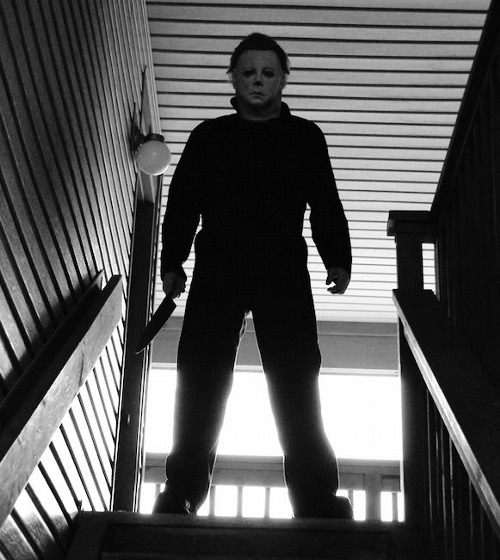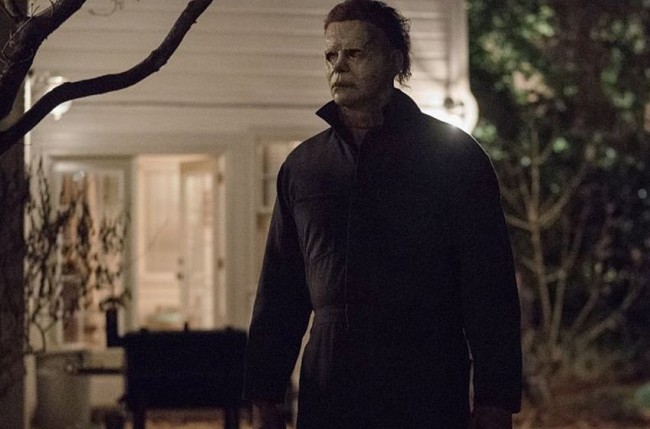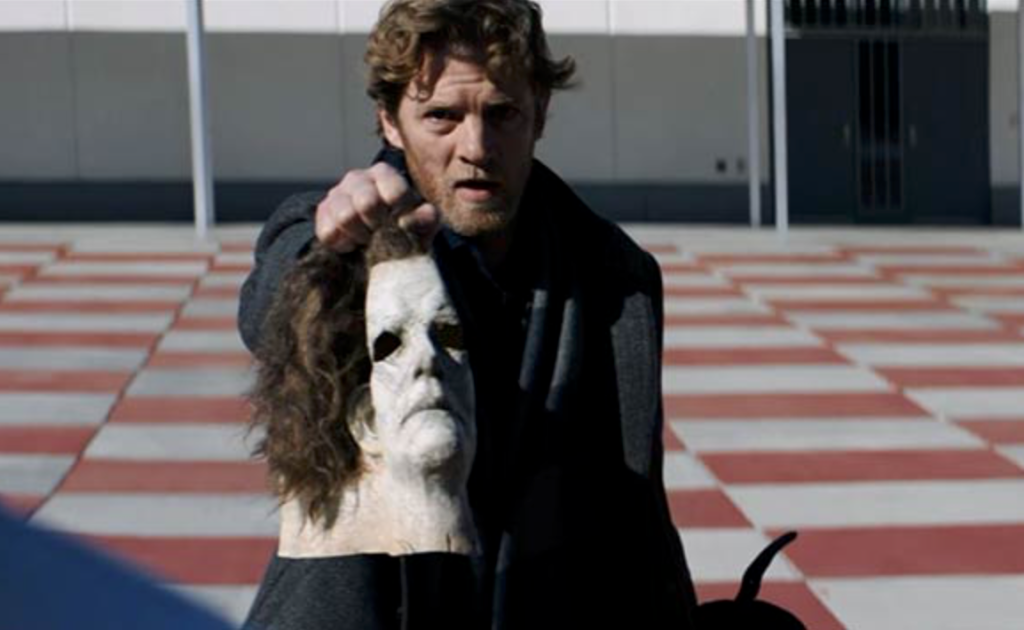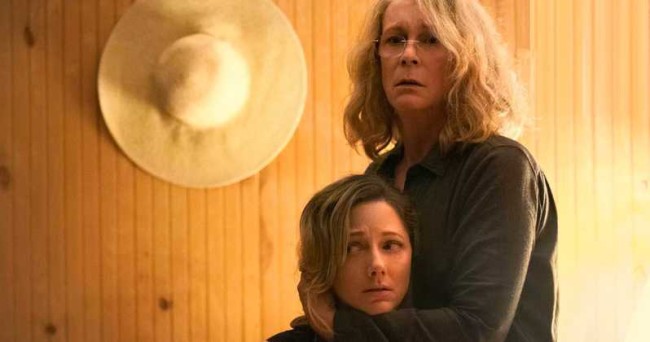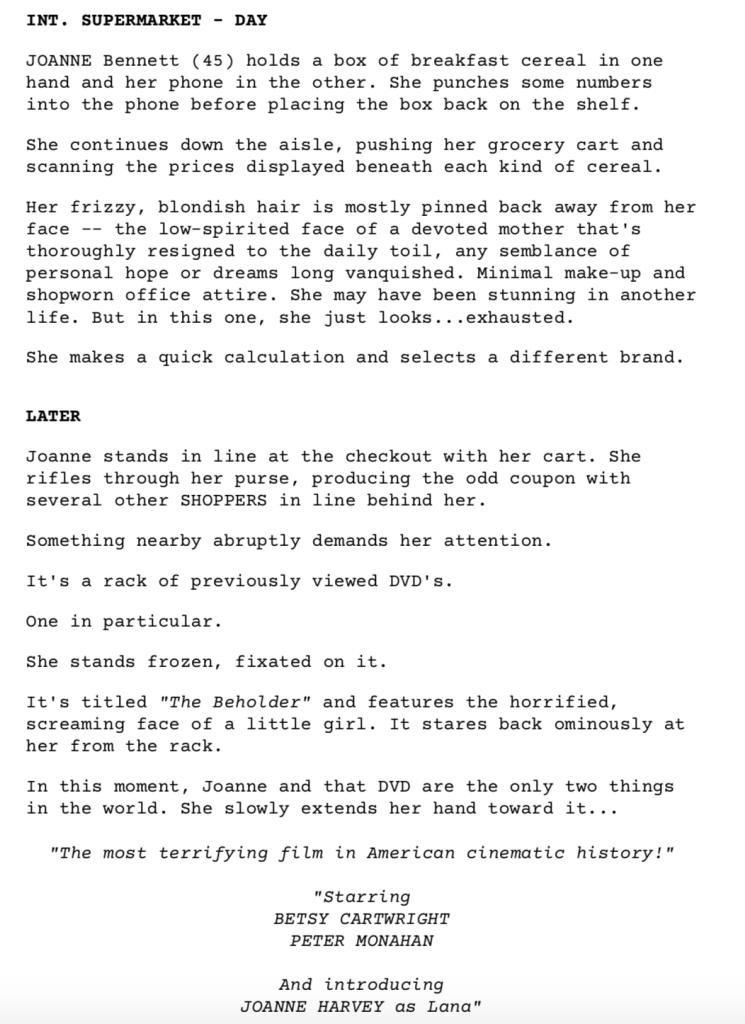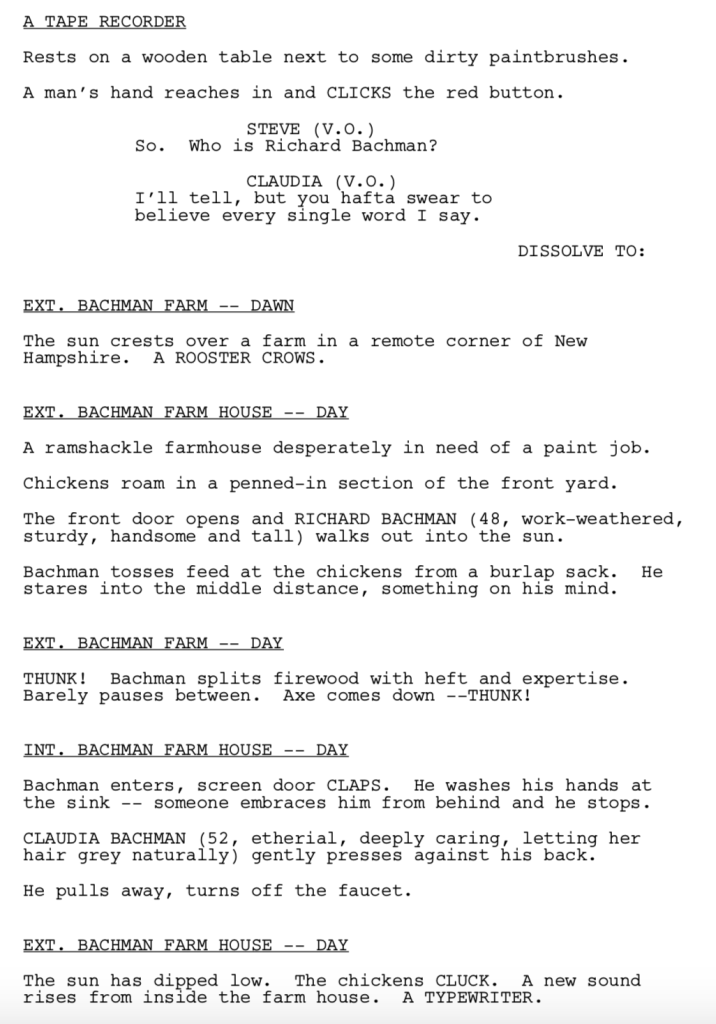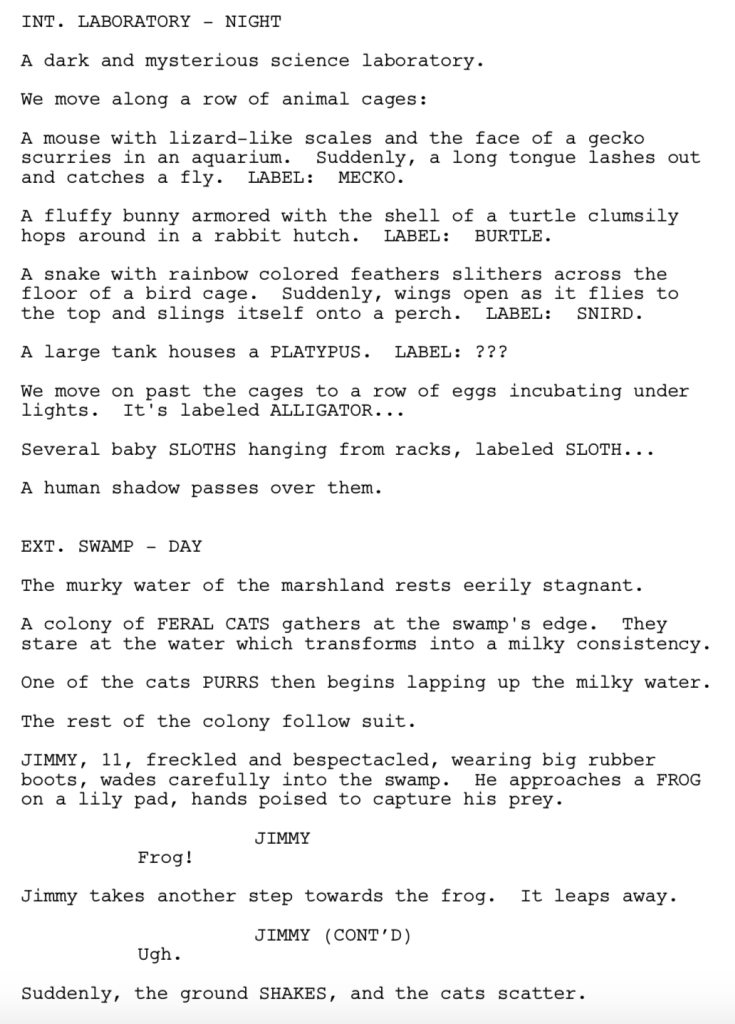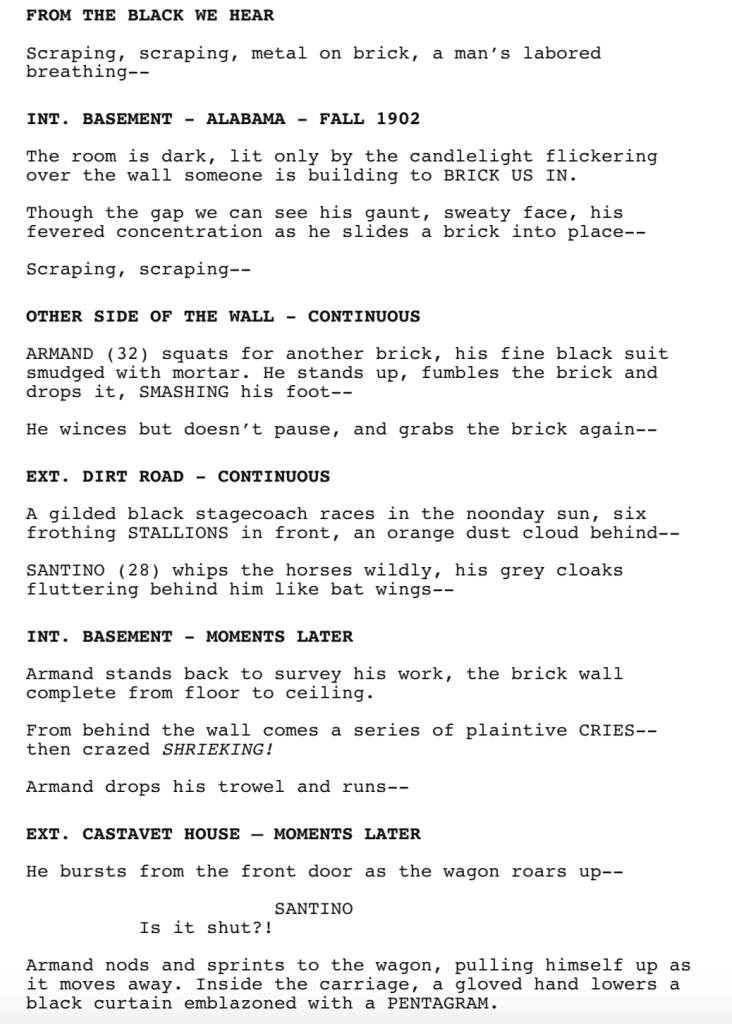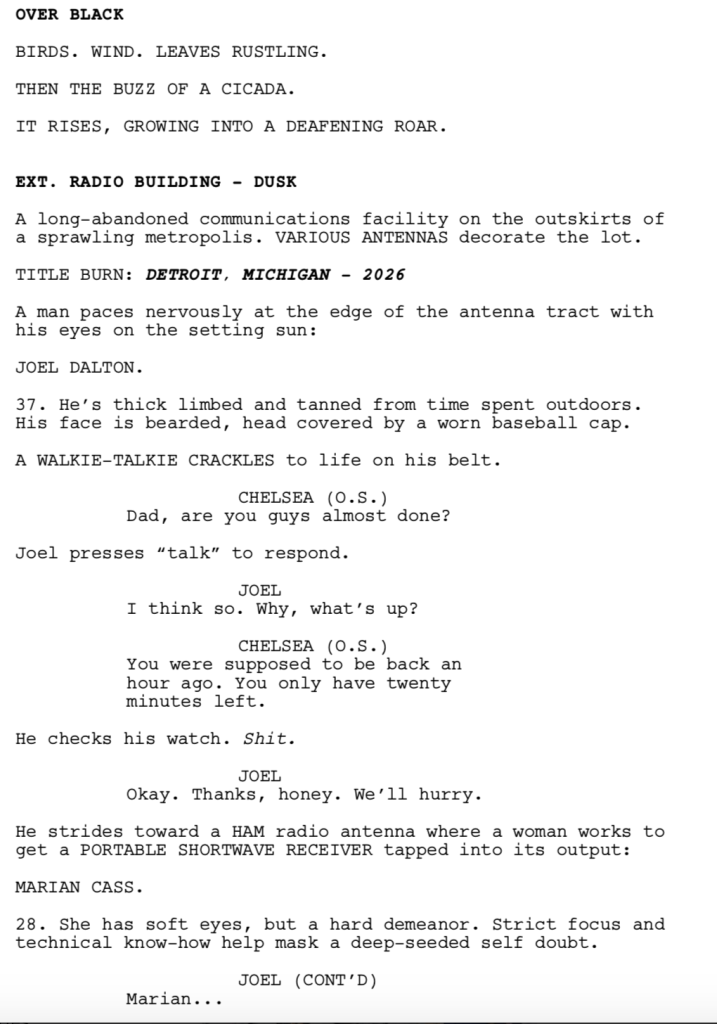Great teasers are expected in horror scripts – When you write a horror film, you HAVE to write a great teaser scene. It’s expected. The teaser in 2018’s Halloween was the most memorable scene in the film. And the same can be said for this Halloween – a boy wearing a mask murders his naked sister in POV. If a horror script gives me a lame teaser, it’s a guarantee that the rest of the script is going to be lame as well.
Bodies in motion – I like when scripts start with something HAPPENING. The characters are IN MOTION, on their way to something. In contrast, bad scripts often begin with characters sitting around. Nobody wants anything. Nobody’s trying to do anything. This sets the tone for a slow dull movie. Get your characters moving after the teaser, preferably doing something that sets the story in motion. After the teaser in Halloween, we cut to Dr. Loomis and a nurse in a car driving to the mental institution to talk to Michael. We’re off to the races already!
Save the Cat still works! – If you’re ever in doubt about whether your hero is likable enough, give them a Save the Cat! scene. It doesn’t even have to be some big production. Like saving an old woman from getting hit by a car. With Laurie, it’s a simple scene where she runs into the boy she’s babysitting that night. The boy clearly loves Laurie, and she’s adorable with him, adhering to all of his demands (watch a movie, make jack-o-lanters, read to him, make popcorn). It’s a short scene, but just like that kid, we now love Laurie as well. The scene speaks to the power of simplicity in storytelling, as pretty much every choice in Halloween is a simple one.
Build build build – In a horror movie, you don’t want your killer to start killing people right away. You want to BUILD towards it. Tease it. Draw out the suspense. Someone’s broken into the local hardware store and stolen a bunch of stuff. Laurie sees a strange figure in a mask standing across from the school. Then a couple of additional times, behind a bush, and in her yard. We’re building building building before the terror is unleashed.
The scariest things don’t have to be complicated – The reason Michael Myers is still terrifying after 40 years is that he’s so simple. A killing machine in an expressionless mask who never says a word. I bring this up only because people think today’s characters have to have really elaborate backstories and motivations. And while that works when done well, sometimes all you need is a simple terrifying monster.
Horror works best under a tight time constraint – Halloween takes place in less than a day. The majority of it takes place in real time. That’s when horror cooks the hottest, when the threat is so immediate that your characters have to deal with it NOW.
Integrate both active and passive storylines – One of the problems with these horror-slasher screenplays is that the victim is passive. Laurie doesn’t know that this man is after her. So she can’t go after anything herself. All she can do is live her life, and unfortunately, our lives are pretty boring. The solution to this is to add an active storyline. This is usually done by bringing in a policeman or detective who’s chasing the bad guy. Halloween does it with Dr. Loomis. He knows Michael will go back to Haddonfield, which is why he goes back there, to try and catch him. This allows you to cut back and forth between Laurie’s passive storyline and Dr. Loomis’s active one.
Dramatic Irony Alert – Remember that dramatic irony is when the audience knows something the character does not. It’s a device you should be using a lot as a horror writer. After Michael kills the guy who’s gone to grab a beer for his girlfriend, Michael puts on a sheet and walks upstairs to the girlfriend, who’s waiting in bed. She giggles when she sees her “boyfriend” in the sheet, and asks for her beer. WE know this isn’t her boyfriend. SHE does not. Hence the dramatic irony. This allows us to squirm and scream, desperately hoping she’ll find out before it’s too late.
The False Kill – Nearly every horror movie has a false kill of the monster/killer near the end of the film. Unfortunately, audiences have gotten hip to this and don’t believe it anymore. “Make sure he’s dead!” they’re screaming as the hero ignores this obvious advice. So if you’re going to do this these days, you want to use every trick in the book to convince the audience the monster is dead. That way, when they come back, we’re genuinely surprised. Unfortunately, Halloween is not one of these movies. Laurie weakly stabs Michael, who falls down behind a couch, and Laurie assumes he’s dead without even checking. Of course, only minutes later, he’s back on her trail.
We’ll forgive a basic plot if we like the hero – Yesterday I said that a cool plot cannot survive weak characters. The opposite is also true. A bad plot can be saved by strong characters. And when I say “characters,” I’m really talking about your hero. This might be the biggest screenwriting hack of all. If you give us a hero we really like, we’ll pretty much forgive everything else. Everything in Halloween is predictable. A killer escapes a mental institution. Some teenagers are baby-sitting that night. The killer finds them and kills them one-by-one. That’s basic horror movie 101. But we like Laurie so much that we don’t need a big fancy plot with lots of twists and turns. All we want is for her to survive. If that happens, we’ll have enjoyed the experience.
Today’s review asks the question, “When it comes to Horror, is slow the way to go?”
Genre: Horror
Premise: A group of twenty-somethings go camping in the forest for the weekend only to find themselves trapped by a growing form of man-eating sludge.
About: This script made last year’s Blood List. Kevin Kolsch and Dennis Widmyer are writer-directors who made Starry Eyes, Holidays, and who just recently completed shooting the new Pet Cemetery.
Writers: Kevin Kolsch & Dennis Widmyer
Details: 89 pages – 3/8/17 draft
You would think, when it comes to horror, that the scariest things would be the things that strike the fastest. And while in real life, that may be true, the opposite seems to be the case in film. Zombies move at one-fifth the speed of the average man. Yet there’s nothing more terrifying than a group of zombies stumbling towards someone when there’s nowhere to hide. A ghost who appears on the opposite end of the room is equally terrifying. And it doesn’t have to move at all.
Why is this the case? Well, it’s because horror works best in the LEAD-UP to the attack as opposed to the attack itself. The slower the monster moves, the more you get to milk the suspense. And the suspense is where our fear resides. This isn’t always the case, of course. The T-1000 in Terminator 2 was pretty damn fast. But it serves as a reminder that when you’re picking your horror concept, not to overlook slow.
Twenty-somethings Rich, his girlfriend Katie, Fitz, and his girlfriend Ziggy, are taking the weekend to explore a cool isolated waterfall Rich knows about deep in the woods. Katie’s convinced her younger resistant sister, Kimberly, to join them. Millennial mindsets lead to a lot of bickering about how far they have to walk, until they come across a large fence, which Rich doesn’t remember being there. Eh, no worries. They cut through the fence and finally find the spot.
After Kimberly refuses to join the crew in a skinny dip, bitch Ziggy starts heckling her. The two get into a scuffle and Kimberly storms back to the car. Unfortunately, she doesn’t make it. While crossing a seemingly normal pathway, she begins to sink into the ground. She screams for help, but no one hears, and she slowly disappears below the surface.
Back by the water, Katie starts to worry about her sister, and recruits the others to look for her. Rich branches off, finds a large mud patch, and sees the outline of Kimberly inside of it. Rich runs over to pull her out, but quickly finds himself sinking as well. The rest of the group arrives, and Rich explains to them that they have to stay away. He’s in some kind of quicksand, but it’s not like normal quicksand. It burns.
As the group tries to figure out a way to save Rich, Rich decides to get the car keys out of his pocket so the rest of them can go for help. He gets the keys, but when he lifts his hands, the skin and flesh fall away like hot oatmeal. Definitely not your average quicksand. Rich dies soonafter, sinking into the muck, but his hand and the keys remain lifted in the air. “Why hasn’t he sunk all the way?” they ask. “It’s taunting you,” Katie says. It’s then that they realize, this death-quicksand is alive. And it’s going to eat each and every one of them before they can escape this place.
As you can see, our antagonist is about as slow as can be. Sludge. It needs you to walk into it, as opposed to it coming to you. And once you’re in it, you don’t die right away. You die a slow agonizing death. This allows you to create long drawn-out suspenseful scenes where characters get caught, and all you can do is watch from the sidelines as they dip deeper and deeper into their grave.
As a writer, this is a dream scenario, because you can belt out large sequences that are inherently nail-biting. One of the primary scenes in the script – Rich getting stuck in the mud and needing to get keys out of his pocket so the rest of them can escape – is 17 pages!! That’s one-sixth of your screenplay right there! That’s what you call your premise doing your work for you.
Unfortunately, the writers make a classic horror mistake. They don’t put enough work into the characters. The audience only cares about a character in peril if they care about the character. So it doesn’t matter how suspenseful a scene is if we don’t care about the people participating in that suspense. Everyone in The Swallow is a cardboard cutout. You want to know how the first character in the script is described? “RICH (23, rugged, handsome).”
That’s it. That’s an actual description. Do you want to know how many characters I’ve seen described as “rugged and handsome” in the 7500 scripts I’ve read? At least 500. Probably more. If you’re going to describe someone generically, how can I not see them as anything other than generic?
There are some writers who will argue that you want to keep your descriptions generic because, that way, you keep the casting as wide open as possible. I can go along with that IF the characters then take action or make choices that define them. You don’t need to give Han Solo some Pulitzer-winning description as long as you have him kill Greedo a couple minutes later. That ACTION just told me everything I need to know about Han Solo, regardless of what his introduction was.
Likewise, I’ll forgive a sparse description if the characters reveal themselves through dialogue. Go watch The Breakfast Club. Those characters are the defining examples of characters we know due to what they say. I’m looking for originality, specificity, and creativity in dialogue, particularly from characters this young. 22 year olds are going to be on the cutting edge of slang. Here, the dialogue is extremely basic. There’s no personality to it at all.
So if you’re going to get a horror script right, guys, you have to get the characters right. I mean look at Monday’s film, Halloween. It wasn’t perfect. However, there was a LOT of character work stuffed in there. Laurie Strode had a super-extensive backstory. The granddaughter is dealing with the complexity of wanting her grandmother back in the family despite the fact that her own mom has disowned her. In The Swallow, the only backstory is the car ride it took to get here. Without depth, without originality, without personality, how can we connect to your characters.
Honestly, I blame 80s horror for this. A lot of people see that decade as the Golden Age of horror and it basically amounted to a cool killer and a bunch of nameless victims. Not to say some of those movies aren’t fun. But filmgoers are more discerning today. They need to connect, if only a little, in order to stay invested. Remember, they’ve always got their phones and their computers next to them if you don’t do your job.
The Swallow is a pretty fun idea. And I could see this being made. But you need someone to come in and rewrite these characters. Right now, they’re not enough.
[ ] What the hell did I just read?
[x] wasn’t for me
[ ] worth the read
[ ] impressive
[ ] genius
What I learned: Don’t describe a character in a way that you can SHOW the character. One of the characters here is described as “quick-witted.” Why would you tell us that? Just show us. The very first time somebody says something to that character, have that character come back with something quick-witted. Boom, you’ve done your job. We now know they’re quick-witted.
Out of the office today, everyone. :) Couldn’t leave you totally hanging, though. So here’s a tip you can integrate into your script RIGHT NOW. That’s right, I want you to go write a scene as soon as you’re done reading this.
TIP: One of the easiest ways to write a a good dialogue scene is to give us one character who doesn’t want to talk and one character who does. Resistance creates conflict. Conflict drives dialogue. We saw this to the extreme in yesterday’s review, where the podcaster at the beginning of the movie wants to talk to Michael. But Michael doesn’t want to talk to him. Personally, I think this is more fun if the secondary character does some talking. But go ahead, try it out. You usually get a good scene out of it.
Genre: Horror
Premise: (from IMDB) Laurie Strode comes to her final confrontation with Michael Myers, the masked figure who has haunted her since she narrowly escaped his killing spree on Halloween night four decades ago.
About: The chameleon’esque David Gordon Green (Pineapple Express) won this sequel by pitching his unique take on the franchise: “What if none of the sequels happened?” Funny enough, he didn’t yet know if he could get Jamie Lee Curtis for the part. Before landing her, he considered doing a Force Awakens soft-reboot approach. But Curtis signed on within 24 hours of reading the script, and a buzzy Halloween project was on its way.
Writers: David Gordon Green, Danny McBride, Jeff Fradley (characters by John Carpenter and Debra Hill)
Details: 105 minutes
The opening scene of Halloween (2018) does something so drastically wrong, I was convinced the movie was doomed. I’ll get to that mistake in a second. But first, it’s time to give credit to this reboot. There is nothing cooler in Hollywood than a surprise hit – when a film does better than everyone expected (77 million dollar opening weekend!). It reminds us not only what’s possible, but of why we became drawn to this industry in the first place. To chase the high of one day writing a movie that everybody goes to see.
For those who haven’t seen the film, the original “Final Girl,” Laurie Strode, is all grown up. The 50+ grandma lives in a house/bunker of sorts, where she’s spent 40 years preparing in case the man who attacked her and killed 5 people, Michael Myers, escapes the nearby psychiatric ward. Her mother, Karen, has given up on her, while her granddaughter, Allyson, hopes to bring her back into the family fold.
Meanwhile, a couple of British podcasters are doing a podcast on the Michael Myers killing, which introduces the plot point that Michael Myers is being transferred to a prison for the end of his days. Since it wouldn’t be a movie unless that prison bus crashed, the prison bus crashes, and Laurie goes into psycho prep mode, getting her family to her house so they can wait out Michael’s arrival. After killing a half-dozen poor souls, Michael indeed shows up, and the big battle is on.
So let’s talk about that opening scene, shall we?
In it, our podcasters, Aaron and Dana, arrive at the psychiatric ward to meet the subject of their podcast, Michael Myers. They’re joined by Michael’s doctor, Dr. Sartain, and head out to a concrete yard where all the patients are tethered to sectioned-off squares. The giant lumbering Michael is in the middle of the yard, his back to us.
An eager Aaron gets right up to the edge of Michael’s allotted square and starts blabbering away. When Michael doesn’t turn around, Aaron says he “brought something” for him. He then takes out Michael’s infamous mask. As he does, the other patients begin to unravel. They start mumbling, then pacing, then grumbling, then yelping, then yelling, eventually becoming a yard full of riled up chimpanzees. Michael, however, never turns around. As this is happening, Dana looks back at Michael’s doctor, who gives her, I kid you not, an “It’s okay,” nod, allowing Aaron to continue. The scene eventually cuts to the opening titles.
On the surface, this scene is great. I loved that they did the opposite of what was expected, which is to present Michael in a small secured room, a la Hannibal Lecter. To take us outside in broad daylight, especially with all the patients constrained to their own little sections, was perfect. It started off great.
And then it fell apart.
Why are the patients jumping around, hooting and screaming like chimpanzees? They have no idea what this mask is. They don’t know what this presentation represents. But the worst part is when Dana looks back to Dr. Sartain as if to say, “Is this okay?” and Dr. Sartain nods a, “Yeah, this is fine. Let’s see what happens.”
Holdupholdupholdup.
Let me get this straight. You have a psychopathic killer. He’s being presented with the symbol of his killings. You have a bunch of people screaming at the top of their lungs. And you just… allow it to happen???
A certified doctor whose only job is to ensure the well-being of his patients is allowing something to be shown that may reignite his most dangerous patient? What kind of nonsense logic is this?
The ONLY reason any of these things are happening is because the writer wants them to, not because they would. You can never violate that contract with your audience. Once you do, consciously or subconsciously, the audience knows something is wrong. Their suspension of disbelief has either broken or cracked. I mean seriously. What doctor in their right mind is going to allow this to happen? None. Not a single one.
And that’s too bad. Because the framework for this scene is strong. But you need to hold yourself to higher standards. By being truthful, you could’ve made this scene great.
Sure enough, this foreshadowed similar problematic scenes. Laurie Strode has been presented as this backwoods badass who’s been training for battle for 40 years. Yet the first moment she encounters Michael, who she learns is somewhere outside her house, she inches her way up to the windowed door and stands there like a clueless idiot. Sure enough, Michael’s arm shoots through the window, grabs her, and starts bashing her against the door.
Why is this bad screenwriting? Because, clearly, the writer and director wanted an arm-grab-through-the-window moment. They wanted it so bad that they betrayed everything they set up in the character. They introduced her as the world’s most prepared woman, only to turn her into a bumbling moron at the FIRST CHANCE she has to take down Michael. And for what? A cool 30-second struggle? You betray your character for that?? Come on.
You might think with these scathing critiques that I disliked Halloween. You’d be wrong! I actually thought it was pretty good. Namely because of what they did with Laurie Strode. This was a surprisingly deep character. Instead of slapping a “crazy” label on Laurie then blasting us with a bunch of silly Halloween kills, this movie asks what would’ve happened to someone like this, the lone survivor of a tabloid-grabbing murder spree. And they dig deep into Laurie’s psychology, specifically her relationship with her daughter and granddaughter. I loved that they didn’t shy away from that. And it’s why moments like the door scene bothered me so much. Because they put chinks in what was a great character, especially for a 50+ year old woman. Roles with this kind of depth are rare to find for this demo.
And there were quite a few scary moments. One of my favorites was when a father and son drove up on the prison bus crash in the dead of a foggy night. With their headlights illuminating the wandering bodies of the patients on the road, you just knew Michael was out there lurking. More importantly, it went against the traditional horror setup, which is to place your characters in small spaces where there isn’t any room to maneuver. Here, it was wide open (just like the opening scene) and still terrifying as hell.
The next good scare (spoiler!!) occurred on the opposite end of the spectrum. A newly deranged Dr. Sartain places a blacked-out Michael Myers in the back seat of the cop car with Allyson. We go from the most wide-open space to the most contained. And props to the writers for drawing this moment out. Again, scenes like this are never about the struggle once the character wakes up. They’re about milking the moments UNTIL the character wakes up. You sit on that. You make the audience dread it. And dread it we do. Is there anything more terrifying than the possibility of Michael Myers waking up next you in a room you can’t escape from?
Unfortunately, Halloween feels like a script that needed 2 to 3 more drafts. The story is designed to have Laurie and Michael duke it out at her house in the final act. And had you told me that was the selling point, I’d have been excited. But everything about the climax is clumsy. For someone who’s been preparing 40 years for this, Laurie doesn’t seem to have much of a plan outside of “turn the backyard lights on.”
An easy way to tell they were rushing was the featured kitchen contraption – an island that slid out of the way revealing a secret trap door to the basement. They must’ve showed that thing opening and closing a dozen times in the last 20 minutes. It was way overused. Rewrites allow you to consolidate and streamline hiccups like that.
All in all, Halloween was a “liked it, didn’t love it” film. It had its moments. Its heart was in the right place. But you left feeling like they dropped the pumpkin. Too bad. Maybe the next one will be better.
[ ] What the hell did I just read?
[ ] wasn’t for me
[x] worth the price of admission
[ ] impressive
[ ] genius
What I learned: Create actions that oppose the setting. This always works. The idea is you have a setting, then you make a character perform an action that normally wouldn’t happen in that setting. For example, Allyson’s family is having dinner at a restaurant. Restaurants are supposed to be fun happy places where you eat and enjoy conversation. However, Laurie shows up unexpectedly, sits down, starts talking, then, out of nowhere, bursts into tears. The family becomes incredibly uncomfortable, and, boom, now we have a scene. It’s a subtle trick, this “contrast in place and action.” But it tends to work well. To understand the power of this device, imagine the exact same scene occurring, but back at the family home. It’s not nearly as interesting, is it?
Holy Slutty Halloween Costume! There were a TON of Halloween Amateur Offerings entries. If I’d known there were going to be this many, I would have created a more elaborate competition. Alas, it’s a cut-throat business out there. As per the rules of the game, only five of you made it in. It wasn’t easy pickings. I tried to cover multiple sub-genres so not everything felt the same. Unfortunately, this meant that some strong contenders didn’t get in. Who knows, maybe I’ll throw a few of these into a future competition.
Since I have to stay out of the comments (can’t be persuaded by the reactions), I’ll be checking out the latest Halloween movie this weekend, then review it on Monday. There’s a lesson in “Halloween” for aspiring screenwriters, by the way. One of the things that will happen when you break in, is that you’ll meet with a bunch of people in town. Some of these people will own famous old properties. If you can come in and pitch a fresh take on one of these properties, they may pay you to write a draft. David Gordon Green and Danny McBride came up with this idea of, “What if we pretended that none of the Halloween sequels existed and made this a straight sequel to the original Halloween?” The studio liked that take and allowed them to make the movie. So when that opportunity comes for you, be ready! Have a take formed and a pitch prepared. Even if they had no intention of bringing it up themselves. “Hey, I know you guys own Nightmare on Elm Street. I have an idea for a sequel.” What are they going to say? “We don’t want to hear it?” Of course they do. So be ready!
If you haven’t trick or treated at the Amateur Offerings house before, here’s how the game is played. Read as much of each screenplay as you can, then vote for your favorite script in the Comments Section. Voting closes on Sunday night, 11:59pm Pacific Time. Winner gets a review next Friday. — If you’d like to submit your own script to compete in a future Amateur Offerings, send a PDF of your script to carsonreeves3@gmail.com with the title, genre, logline, and why you think your script should get a shot.
Oh, and one last thing. Move over Trajent Future. Out of the way Larry the Lyft Driver. Sayonara Orbitals. I’m pretty sure “Slothigator” just became the newest Scriptshadow Meme.
Title: THE EVIL EYE
Genre: Horror
Logline: Something terrifying awakens within a middle-aged mom when she finally decides to watch the now-classic horror film that she starred in as a child.
Why You Should Read: To this day, rumors persist of a supposed “curse” attached to the modern classic horror film, “The Beholder”. The movie enjoyed both critical acclaim and box office success upon its premiere in October of 1983, and it is still commonly hailed as being among the most terrifying films in the history of American cinema.
But the film’s production was plagued by an endless string of on-set accidents, misfortune and tragedy. And the “curse” only seemed to intensify in the months and years following the movie’s release with the mysterious and untimely deaths of many of the cast and crew, including director John Friedman and lead actors, Betsy Cartwright and Peter Monahan.
Only nine years old at the time, the film’s youngest star, Joanne Harvey, seemed poised to take the movie industry by storm. But in the wake of an auto accident that claimed the lives of her parents after the premiere of “The Beholder”, Joanne Harvey disappeared from Hollywood, never to be heard from again.
Title: The Bachman Books
Genre: Horror/Biopic
Logline: A freelance journalist becomes entangled in one of the greatest literary coverups of the 20th century. Based on a true lie.
Why You Should Read: This is based on the true story of the journalist who discovered that Stephen King was writing under the pseudonym Richard Bachman – and I should know, because that journalist is me, Steven P. Brown. – Consider this a sidebar to the real story, which involved a simple trip to the library of congress, where I pulled the copyrights to the Bachman books. Boring! What if, in my pursuit of the truth, I got roped into a terrifying game of cat and mouse with a man claiming to be the real Richard Bachman? You mention that a surefire way to break in as a screenwriter is to write a biopic, so I’ve put my own twist on it with a horror/thriller that I hope would make Mr. King himself proud.
Title: Slothigator
Genre: Horror Comedy
Logline: A dysfunctional family must work together when a giant, man-eating sloth/alligator hybrid creature wreaks havoc at their Louisiana amusement park.
Why You Should Read: Despite it’s admittedly bonkers premise, Slothigator offers a healthy share of sentimental family drama to accompany its creature-feature gore fest. By providing the audience with a well rounded family, we believe Slothigator goes beyond its genre and would be able to connect with the audience at a more personal level. After months of sleepless, research filled nights, we can confirm that the science presented in this script is 100% accurate.
Title: In the Basement
Genre: Family Horror
Logline: When some neighborhood kids go trespassing in an abandoned house, they accidentally open the door to Hell, and have to battle a crazed demon horde to close it back before the Devil escapes.
Why You Should Read: Poltergeist is easily one the best, scariest movies ever made, yet somehow it’s for the entire family (well, minus the face-ripping scene). Recently, Amblin has returned to family horror with the House With a Clock in Its Walls—according to Eli Roth, Spielberg told him to make it as scary as possible, that “kids love good scares.” I agree, but every Halloween I’m reminded there aren’t really that many quality horror movies for kids. ‘In the Basement’ takes up the challenge, and is intended to scare the shit out of little kids while keeping things fun and exciting (it’s “fun scary,” as I would tell my kids). The script has gotten some festival love, and was a finalist at Crimson Screen and a Night of Horrors. I hope you enjoy, particularly if you’re under the age of 15.
Title: BLACK LIGHT
Genre: Monster / Action
Logline: In a world overrun by nocturnal monsters only seen under black light, four survivors are forced to travel overnight through a post-apocalyptic Detroit in order to reach a boat that will take them to safety.
Why You Should Read: Not only is it a character based horror film with a hook, but it’s also got some kick ass, Carson-inspired G.S.U. going on. Four people who need to get from one place to another — only five miles — but they have to do it overnight in a world where the last thing you’d ever want to do is go out past dark. Basically, I set out to write something big and fun with cool / scary set pieces and limited locations to keep the budget managable. Think ALIENS meets FURY ROAD with a touch of TREMORS sprinkled in for good taste. As far as I’m concerned, if it turned out even remotely similar to any of those three films, then it would have to be worth some kind of consideration. And yes, I understand that’s a big “if.” Either way, thanks for taking the time and happy Halloween.


